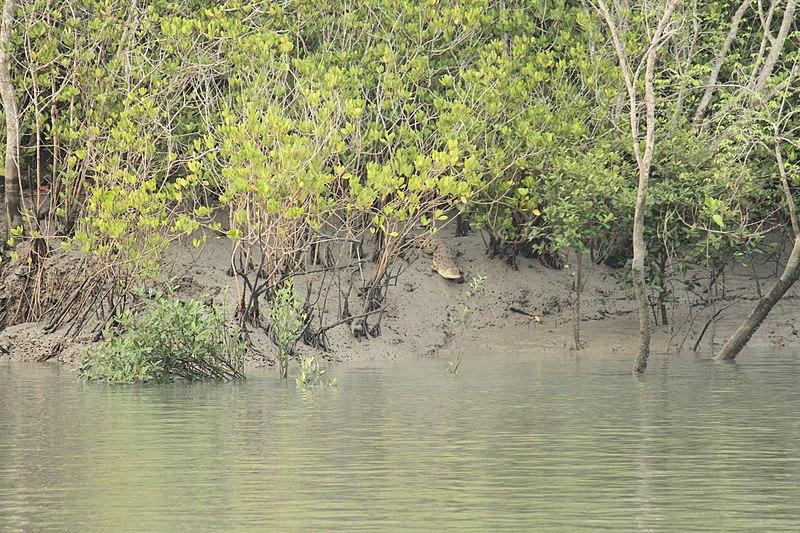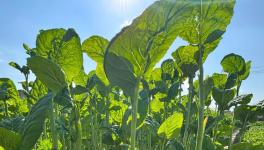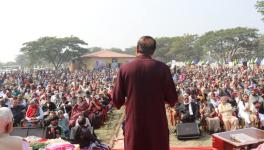World Environment Day: Sundarbans Faces Biodiversity Challenge, say Experts

Image Courtesy: Wikimedia Commons
Gosaba: Experts warn that the Sundarbans, a unique and ecologically diverse region, is grappling with the daunting task of preserving its biodiversity. As World Environment Day approaches, concerns are mounting among experts and locals alike over the depletion of mangroves, the increasing plastic waste problem, and the impact of climate change on the region.
Local residents, such as grocery shop owner Bidyut Gharami, explained to NewsClick the challenges they face in maintaining their livelihoods amidst these environmental pressures. In Gosaba's Chotomollakhali Bazaar, Bidyut Gharami, a 39-year-old grocery shop owner, is satisfied with maintaining his small store to sustain his livelihood. However, in recent times, there has been a growing issue of plastic waste accumulation near the riverbanks next to his shop. He admitted that plastics have become a headache for the local residents.
Locals Concerned
The depletion of mangroves in the Sundarbans has resulted in more severe storms like Amphan or Yass, causing greater devastation than in previous years, the shop owner said. Gharami also mentioned the unbearable heat this year, even in the river-centric localities of the Sundarbans.
He acknowledged that fewer fish are in the waters than in previous years, and mangroves have been disappearing throughout the region. When Paschim Banga Vigyan Manch activists approached him with leaflets, he agreed that tackling the plastic menace was necessary.
However, Gharami pointed out that his grocery shop relies on hundreds of items packaged in plastic, making it a challenge to switch to alternatives like paper packaging.
NewsClick also spoke with Biswajit Mridha, a 31-year-old teacher and native of the island. He noted that the people of the Sundarbans are now experiencing the impact of global warming, with temperatures reaching up to 40 degrees Celsius, which is unprecedented in the region.
Mridha expressed concerns about the depletion of groundwater and the appearance of yellowish saline fluid when drilling wells, making it difficult for paddy trees to grow. He mentioned that only hybrid paddy seeds are available in the market, which cannot withstand the salinity. However, he was hopeful when informed about alternative paddy seeds that can thrive in the Sundarbans.
Mridha said that the biodiversity of the region is also under threat.
In Gosaba, there are 14 islands that make up the Gosaba block. Chotomollakhali is one such island nestled between the Bidyadhari and Raimangal rivers.
A team of scientists and environmentalists from Paschim Banga Vigyan Manch recently visited these remote islands of the Sundarbans. They carried the message of abandoning plastics, protecting mangroves, using bio-pesticide fertilisers instead of chemicals, and promoting social forestry by planting mangroves.
The Sundarbans Delta has only 3 lakh hectares of cultivable land, with irrigation facilities available in only about 20 to 25% of the area. The remaining lands depend solely on monsoon rainfall, as groundwater resources are insufficient for cultivation.
During the Aila cyclone in 2009, sweet water cultivation was severely affected when most of the lands got inundated. Despite the government's declared minimum support price, paddy sells for much less, causing many inhabitants of the Sundarbans to become migrant labourers.
Expert Visit to Sunderbans
The team of scientists from Paschim Banga Vigyan Manch, led by Dr Pradip Mahapatra from the Department of Chemistry at Jadavpur University and the secretary of the organisation, along with environmentalists Sourav Chakraborty, SK Soleman, and agricultural scientist Abhinandan Banerjee, visited several islands in the vicinity.
The launch of Vigyan Manch included street plays and dance dramas to raise awareness about conserving water resources and other environmental issues.
Dr Pradip Mahapatra highlighted the dangers of microplastics in the water and the greenhouse effect causing global warming. He explained that the Sundarbans are particularly vulnerable, and rising sea levels could lead to the inundation of the entire region.
The programme was organised by the South 24 Parganas district committee of Paschim Banga Vigyan Manch, a science-based movement under the All India People's Science Network. PBVM is the largest science organisation in the country, with over 2.65 lakh members.
Get the latest reports & analysis with people's perspective on Protests, movements & deep analytical videos, discussions of the current affairs in your Telegram app. Subscribe to NewsClick's Telegram channel & get Real-Time updates on stories, as they get published on our website.
























